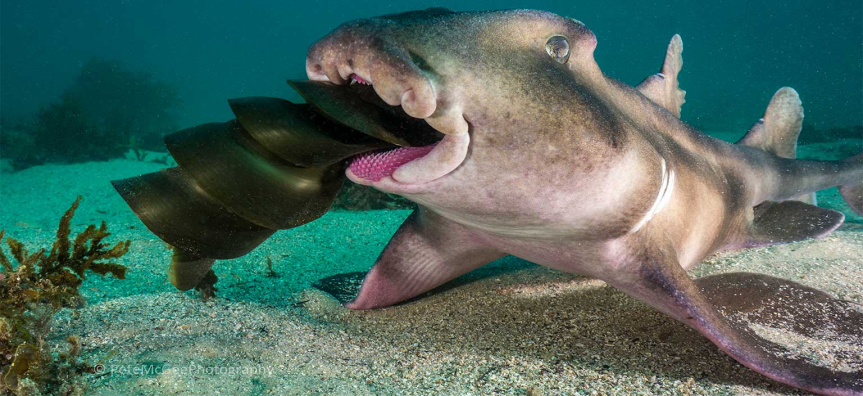
Life Below Water – Cabbage Tree Bay Aquatic Reserve
Port Jackson Shark Video
Interview with Sian Liddy, Marine Ecologist. Sian describes why Cabbage Tree Bay is important for Port Jackson Sharks. The video contains overlay shots of Port Jackson sharks and Sian observing their behaviour underwater in the bay
Video text transcript
(Sian is sitting on the rocks overlooking Cabbage Tree Bay. She describes why Cabbage Tree Bay is important for Port Jackson Sharks. The video contains overlay shots of Port Jackson sharks and Sian observing their behaviour underwater in the bay.)
Sian Liddy: The Port Jackson shark is iconic species to this area - drawn to these shallow, coastal areas like Cabbage Tree Bay because of the sheltered habitat it provides between the months of June to November when they migrate up here from their feeding grounds in the Bass Straits to breed.
You’ll see them mating and depositing their eggs.
These are very placid sharks and they are not considered to be aggressive to humans at all.
They don’t have big, sharp teeth like a larger shark. Instead, they have these grinding plates that they use to crush and break the shells of the animals they eat - things like molluscs, urchins, bony fish.
You’ll be able to recognise it from its blunt shaped head and a really distinctive harness shape which goes along the side of its body. This harness shape is what distinguishes it from its cousin, which is also found in the bay – the Crested Hornshark, which is more of a mottled blotchy colouring.
You’ll mostly find them sitting along the sea floor during the day and becoming more active at night.
Most sharks have to keep swimming to push water along their gills to be able to breathe. Whereas these types of sharks can actually pump water through their gills themselves, which means they can rest during the day and eat and breathe at the same time.
(Sian is holding a Port Jackson shark egg.)
Port Jackson sharks are part of a family of egg laying sharks. The spiral shape allows it to be wedged into the rocks, and helps it camouflage. After 9 – 12 months of development, the embryo will be able to break out of the top there and it will be about 25 centimetres long.
The juvenile sharks will then use sea grass habitat as nursery grounds until they reach about 50 centimetres in length.
Because of the high mortality rate of these eggs and how long it takes these sharks to reach sexual maturity and reproduce as adults, its really important that we protect the ecosystems they live in so the sharks will be around for future generations to come.
